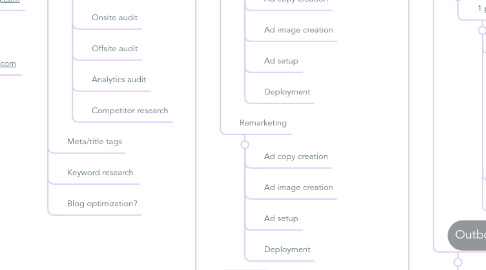
1. Web Wireframe
1.1. Menu Bar
1.1.1. Why Us
1.1.1.1. Respond Faster
1.1.1.2. Empower Users
1.1.1.3. Determine Root Cause
1.1.1.4. Full Lifecycle Management
1.1.1.5. Trent Reporting
1.1.1.6. Demonstrate Compliance
1.1.1.7. Maintain Trust
1.1.1.8. Holistic Risk Approach
1.1.1.9. Risk Visibility Across Silos
1.1.2. Industry
1.1.2.1. Software & Technology
1.1.2.2. Banking
1.1.2.3. Healthcare
1.1.2.4. Insurance
1.1.2.5. Energy
1.1.2.6. Retail
1.1.2.7. Media & Communications
1.1.2.8. Manufacturing
1.1.2.9. Pharmaceuticals
1.1.3. Solutions
1.1.3.1. Cyber Incident Response
1.1.3.2. Forensics Case Management
1.1.3.3. Fraud Management
1.1.3.4. IP Management
1.1.3.5. Compliance
1.1.3.6. Retail Loss Prevention
1.1.3.7. Brand Protection
1.1.3.8. Enterprise Risk Management
1.1.3.9. Physical Security Reporting
1.1.3.10. Business Continuity?
1.1.4. Products
1.1.4.1. Core Engine
1.1.4.2. Connectors/Integrations
1.1.4.3. Intelligence Layer
1.1.4.4. Professional Services
1.1.5. Comapny
1.1.5.1. About Us
1.1.5.2. News & Events
1.1.5.3. Careers
1.1.5.4. Contact Us
1.1.6. Demo
2. OVERVIEW
2.1. GOALS
2.1.1. Increase in SQL's in first 3 months
2.1.2. Have full marketing automation in place
2.2. Buyer Personas
2.2.1. CTO's, IT Directors, Heads of development
3. Resources
3.1. Team Members
3.1.1. Curtis Warren
3.1.1.1. curtisw@foxtailmarketing.com
3.1.2. Frank Young
3.1.2.1. franky@foxtailmarketing.com
3.2. Teamwork
4. SEO Strategy
4.1. Preliminary Full Audit
4.1.1. Conversion audit
4.1.2. Content audit
4.1.3. Onsite audit
4.1.4. Offsite audit
4.1.5. Analytics audit
4.1.6. Competitor research
4.2. Meta/title tags
4.3. Keyword research
4.4. Blog optimization?
5. Ad Strategy
5.1. Adwords
5.1.1. Paid Ads
5.1.1.1. Ad copy creation
5.1.1.2. Ad image creation
5.1.1.3. Ad setup
5.1.1.4. Deployment
5.1.2. Remarketing
5.1.2.1. Ad copy creation
5.1.2.2. Ad image creation
5.1.2.3. Ad setup
5.1.2.4. Deployment
5.2. Social Ads
5.2.1. Content Promotion
5.2.1.1. Paid Ads
5.2.1.1.1. Facebook
5.2.1.1.2. LinkedIn
5.2.1.1.3. Twitter
6. Email Strategy
6.1. Outbound Campaign
6.1.1. Newsletter
6.1.1.1. 1 per month
6.1.1.1.1. Copy writing
6.1.1.1.2. Email Setup
6.1.1.1.3. Deployment
6.1.2. Outbound Blast
6.1.2.1. eBook
6.1.2.1.1. Email copy
6.1.2.1.2. Email setup
6.1.2.1.3. Deployment
6.2. Inbound Campaign
6.2.1. Nurture creation
6.2.1.1. Email copy/setup
6.2.1.2. Nurture setup in HubSpot
6.2.1.3. Set Cadence
6.2.1.4. Lead Scoring Setup Help
6.2.1.5. Deployment
7. Content Strategy
7.1. Blogs
7.1.1. 8 per month
7.1.1.1. ebook/blog series - Building a Better IRP - How to Meet and Exceed NIST Standards
7.1.1.1.1. How Strong is Your Incident IRP?
7.1.1.1.2. The Essential Pieces of an IRP
7.1.1.1.3. Building your IR Team
7.1.1.1.4. Start Building an IRP That Will Exceed NIST Standards with D3
7.1.1.2. ebook/blog series - First Responder's Guide to a Cyber Attack
7.1.1.2.1. The first 24 Hours
7.1.1.2.2. The Next 48 Hours
7.1.1.2.3. The Next 2 Weeks
7.1.1.2.4. Starting the Recovery
7.1.2. How Ready is Your Team for a Pass the Hash Attack (this can be an ongoing series and discuss different types of cyber attacks)
7.1.3. Integrating Patch Management into your Incident Response Strategy
7.1.4. Tips to Help You Manage Your IR Team
7.1.5. Using the Past to Improve the Future - How IT Forensics Can Help Prevent Future Vulnerabilities
7.1.6. Reducing Human Error - How Automating IR Can Help Make Your Cyber Security Air Tight
7.1.7. Is an Ounce of Prevention Really Worth a Pound of Cure? Why You'll Always Need an IRP
7.1.8. Application Whitelisting that Doesn't Handicap Your Employees
7.1.9. Best Practices for Privileged Account Management Security Framework/Strategy
7.1.10. Privilege Management That Lets Your Employees do Just What They Need
7.1.11. concept creation
7.1.12. copy writing
7.1.13. posting?
7.2. Minigraphics
7.2.1. 8 per month
7.2.1.1. 1 per blog
7.2.2. Will be using facts and statistics from the blogs
7.2.3. Design
7.3. eBooks
7.3.1. 1 per month, starting month 2 (September)
7.3.1.1. How to Prevent an IT Security Breach (based on blog series, see above for specifics)
7.3.1.2. Copy creation
7.3.1.3. Design
7.3.1.4. 1Landing page per eBook
7.3.1.4.1. Design
7.3.1.4.2. Copy creation
7.3.1.4.3. CTAs
7.3.1.5. 4-5 email nurture following
7.3.1.5.1. Setup in HubSpot
7.3.2. First Responder's Guide to a Cyber Attack - The First X Hours
7.4. Whitepapers
7.4.1. 1 per month, starting in Sept
7.4.2. Built for Response: Centralize, Standardize, and Act with a Unified IR Platform
7.4.3. Supercharging NIST 800-61: Enhancing Proven Playbooks with Automated Response Orchestration
7.4.4. From Detection to Recovery: 4 Tools that Speed Response through the IR Lifecycle
7.4.5. IR Team Empowerment: 5 Tools that Make Your Team Smarter, Faster, and "Bigger"
7.4.6. Being Prepared Means Being Adaptable (agile): Responding to Dynamic Cyber Attacks with Dynamic Task Orchestration
7.4.7. Make SIEM Actionable: Focus on the Threats that Matter and Reduce Alert Fatigue with Unified IR
7.5. Case Studies
7.5.1. 1 per quarter
7.5.1.1. Concepts creation
7.5.1.2. Gather client info for document
7.5.1.3. Copy creation
7.5.1.4. Design
7.5.1.5. Deploy (emails, nurtures)
7.6. Infographics
7.6.1. 1 per month
7.6.1.1. Timeline of a Cyber Security Attack
7.6.1.1.1. Design
7.6.1.1.2. Deploy
7.6.1.1.3. Gather stats/data
7.6.1.2. Real-World Costs of a Cyber Security Attack
7.7. Video
7.7.1. 4 videos (Sept, Oct, Dec., Jan.)
7.7.2. Video concept
7.7.3. Storyboarding
7.7.4. Creation of video
7.7.5. Deployment
7.8. Buyer Persona
7.8.1. Customer research
7.8.2. Copy creation
7.8.3. Design
7.9. Customer Journey
7.9.1. Customer research
7.9.2. Copy creation
7.9.3. Design
